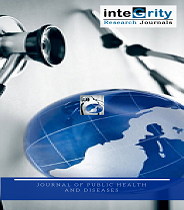
JOURNAL OF PUBLIC HEALTH AND DISEASES
Integrity Research Journals
ISSN: 2705-2214
Model: Open Access/Peer Reviewed
DOI: 10.31248/JPHD
Start Year: 2018
Email: jphd@integrityresjournals.org
Assessing the role of public-private partnerships in enhancing supply chain efficiency for antiretroviral drug distribution: Insights from ten selected health facilities in a state of North Central Nigeria
https://doi.org/10.31248/JPHD2025.150 | Article Number: 80D35B873 | Vol.7 (3) - June 2025
Received Date: 24 March 2025 | Accepted Date: 01 June 2025 | Published Date: 30 June 2025
Author: Kyahar, I. F.
Keywords: Delivery lead time, HIV/AIDS supply chain, on-time delivery, public-private partnerships (PPPs), stockout rate.
Public-private partnerships (PPPs) play a crucial role in enhancing the efficiency and sustainability of HIV/AIDS supply chains in Nigeria. The key objective of the study was to assess the role of PPPs in enhancing supply chain efficiency for antiretroviral drug distribution using three key performance indicators (KPIs) in ten public health facilities within a state in North Central, Nigeria. The study evaluates the impact of public-private partnerships (PPPs) on antiretroviral drug supply chain efficiency. It analyses data such as inventory records, requisition orders, delivery logs, patient records, and weekly commodity reports. Additional insights come from partnership agreements, private-sector performance benchmarks, and structured interviews with staff and donors. Key metrics, including stockout rates, delivery lead times, and on-time delivery, assess improvements before and after implementing PPPs. Results showed a significant improvement: the stockout rate decreased from 35.2 to 8.0%, delivery lead time reduced from 13 days to 7 days, and on-time delivery increased from 66.6 to 85.0%. These findings suggest that PPPs enhance supply chain resilience by leveraging private-sector expertise in procurement, distribution, and data management. Strengthening PPP frameworks could further improve supply chain performance, minimise stockouts, and ensure continuous access to life-saving HIV/AIDS commodities across Nigeria.
| Ayodele, A., Isabel, N. A., & Stella, F. U. (2023). A 2-year assessment of the performance of the supply chain of antiretroviral medicines in supported health facilities in Osun State, Southwest Nigeria. African Journal of Pharmaceutical Research and Development, 15(2), 36-44. | ||||
| Charles, C. E., Ogochukwu, R. E., & Chukwunonso, S. E. (2024). Public-private partnerships in health sector innovation: Lessons from around the world. International Medical Science Research Journal, 4(4), 40-60. https://doi.org/10.51594/imsrj.v4i4.1051 |
||||
| Byomuhangi, E., Kayumba, P. C., & Umuhoza, S. M. (2021). The use of public-private partnerships in health supply chain management in Rwanda. Rwanda Journal of Medicine and Health Sciences, 4(2), 237-256. https://doi.org/10.4314/rjmhs.v4i2.4 |
||||
| Global Fund (2022). Performance monitoring for ART supply chain management. The Global Fund. Retrieved from https://www.theglobalfund.org/en/results/methodology | ||||
| Kumurya, A. S. (2015). Supply chain management of health commodities and logistics: fundamental components of booming medical laboratory services. European Journal of Logistics, Purchasing and Supply Chain Management, 3(4), 62-72. | ||||
| Kunle, R., Ademola, J. I., Babatunde, A. F., Jimmy, A., Taiwo, I., Chrysantus, D., Andrew, O., Daniel, O., Adaeze, A., Umar, B. A., Rose, T., Danladi, C. M., Christopher, B., Ahmad, M. D., & Olusola, O. (2024). Examining public sector availability and supply chain management practices for malaria commodities: Findings from Northern Nigeria. Global Health: Science and Practice, 12(3), 1-12. https://doi.org/10.9745/GHSP-D-22-00547 |
||||
| Mohammad, G., Mostafa, A., Nasrin, S. Z., & Saeed, K. (2022). Role of public-private partnerships in primary healthcare services worldwide: A scoping review. Health Scope, 11(3), e129176. https://doi.org/10.5812/jhealthscope-129176 |
||||
| Naburi, M., & Otieno, P. (2022). The impact of public-private partnerships on logistics costs in the East African Community. International Journal of Supply Chain Management, 11(4), 120-135. | ||||
| National Agency for the Control of AIDS (2023). National HIV and AIDS strategic plan 2023-2027. NACA. Retrieved from https://naca.gov.ng/ | ||||
| Njau, R. J. A., Mosha, F. W., & Savigny, D. (2009). Case studies in public-private partnership in health with the focus on enhancing the accessibility of health interventions. Tanzania Journal of Health Research, 11(4), 235-248. https://doi.org/10.4314/thrb.v11i4.50196 |
||||
| Samira, A., Ehizogie, P. A., Bisola, O. A., Adebukola, A. A., & Emem, H. U. (2024). Public-private partnerships in health sector innovation: Lessons from around the world. Magna Scientia Advanced Biology and Pharmacy, 12(1), 45-59. https://doi.org/10.30574/msabp.2024.12.1.0032 |
||||
| USAID | DELIVER PROJECT. (2019). Manual: Measuring supply chain performance: Guide to key performance indicators for public health managers. Retrieved from https://www.ghsupplychain.org/measuring-supply-chain-performance-guide-key-performance-indicators-public-health-managers. | ||||
| World Health Organisation (2021). WHO Quality assurance policy for the procurement of essential medicines and other health products. Retrieved from https://www.who.int/ publications/i/item/9789240023789. | ||||
| World Health Organisation (2024). HIV data and statistics. Retrieved from https://www.who.int/teams/global-hiv-hepatitis-and-stis-programmes/hiv/strategic-information/hiv-data-and-statistics. | ||||